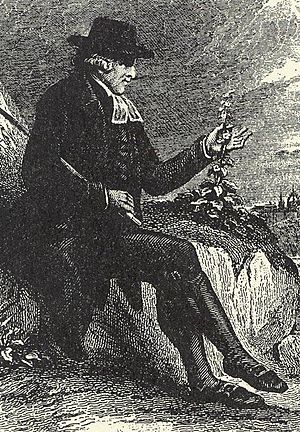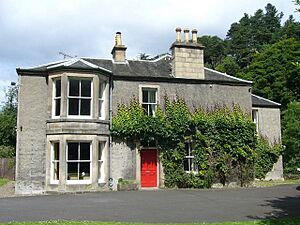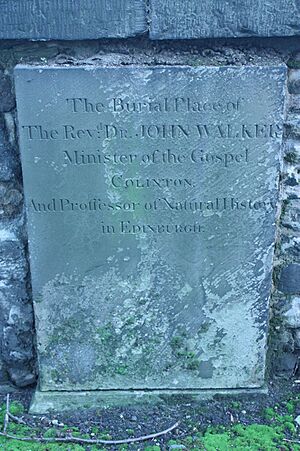John Walker (natural historian) facts for kids
Quick facts for kids
John Walker
FRSE
|
|
|---|---|

Rev Dr John Walker, Edinburgh's Professor of Natural History
|
|
| Born | 1731 Canongate, Edinburgh, Scotland
|
| Died | 31 December 1803 |
| Education | Canongate Grammar School |
| Alma mater | University of Edinburgh (DD; MD) |
| Occupation | Professor of natural history, University of Edinburgh; moderator of the General Assembly of the Church of Scotland |
|
Notable work
|
Schediasma Fossilium (1781) Delineato Fossilium (1782) Classes Fossilium: Sive Characteres Naturales et Chymici Classium et Ordinum in Systemate Minerali (1787) Institutes of Natural History (1792) An economical history of the Hebrides and Highlands of Scotland (1808) Essays on Natural History and Rural Economy (1812) |
| Spouse(s) | Jane Wallace Wauchope (m. 1789; d. 1827) |
| Notes | |
|
Fellowships: Royal Society of Edinburgh, American Philosophical Society, Highland Society
|
|
John Walker (1731–1803) was a Scottish minister and a scientist who studied nature. He was a professor of Natural history at the University of Edinburgh from 1779 to 1803. He helped start the Royal Society of Edinburgh in 1783. He also became the leader of the Church of Scotland's General Assembly in 1790.
Contents
A Brilliant Mind
John Walker was a student of the famous chemist William Cullen. He also worked with other important professors in Edinburgh. These thinkers helped shape the Scottish Enlightenment, a time when new ideas in science and philosophy were very popular in Scotland.
During his life, Walker became an expert in many areas. He studied plants (botany), chemicals (chemistry), rocks and Earth's history (geology). He also studied water (hydrology), weather (meteorology), minerals (mineralogy), and animals (zoology). Besides all this, he was a minister in the Church of Scotland.
Walker was a top scientific advisor in his time. He gave advice on farming, industry, and mining to many powerful Scottish landowners. These included important people like Lord Kames and Lord Bute, who was a prime minister to King George III. Many of Walker's students later became leading scientists in the 1800s. He was also one of the first to teach about farming in a university.
In 1783, Walker became a member of the Royal Society of Edinburgh. This happened when the Philosophical Society of Edinburgh, which he was already part of, received a special royal approval. He served as a secretary for the Society's science section. In 1790, he was chosen as the leader of the Church of Scotland.
Early Life and Studies
John Walker was born in Canongate, Edinburgh, in 1731. His father, also named John Walker, was the headmaster of the Canongate Grammar School. John Jr. went to his father's school.
In 1746, he started studying at the University of Edinburgh. Like many young men in Scotland back then, he studied to become a minister. He earned his divinity degree in 1749. He was allowed to preach in 1754 but officially became a minister in the Church of Scotland in 1758. He first worked in Glencorse, then Moffat, and later Lochmaben.
In 1779, he became a Professor of Natural History at Edinburgh University. He soon found it hard to be both a minister and a professor. So, in 1783, he returned to church work as the minister of Colinton, a town near Edinburgh. He was highly respected and was elected the Moderator of the General Assembly in 1790. He lived in Colinton manse (the minister's house) from 1783 until his death in 1803. He became blind around 1800 but kept preaching.
Even with his church duties, he continued his scientific studies. At university, he took natural philosophy courses. He also collected natural history samples around the Lothians area. In the 1750s, he studied chemistry with Professor William Cullen. He also joined Edinburgh's Philosophical Society. He won awards from the Society and published an article in a famous science journal in 1757. With Cullen's help, Walker became known as a chemist and mineralogist. This led him to advise important people like Lord Bute and Lord Kames on scientific matters.
Becoming a Naturalist
In the 1760s, John Walker used his connections with important families to visit mines across the Scottish Lowlands. He built his own large collection of minerals. By the mid-1760s, he was known as one of Scotland's top naturalists (people who study nature).
Because of his knowledge, the Church of Scotland and a government board sent him on trips. He explored the Scottish Highlands and Hebrides islands in 1764 and 1771. On these trips, he made notes for the church about religion and local cultures. He also took scientific notes on the minerals, plants, animals, and weather of northern Scotland.
During his 1764 trip to the island of Jura, Walker might have been the first to describe Lyme disease in detail. He wrote about the symptoms, like "exquisite pain" in the limbs. He also described the tick that causes it. He called it a "worm" that was "reddish" and "penetrates the skin." Also during this time, he collected samples of a mineral that later became known as strontianite. This helped scientists discover a new element called Strontium.
In the 1770s, Walker published articles in various magazines and journals. It became clear that the University of Edinburgh's Professor of Natural History, Robert Ramsay, needed to be replaced. Walker, with support from William Cullen and Lord Kames, competed for the job. He won the position in 1779 and held it until he died in 1803.
Later Life and Legacy
Professor Walker's natural history lectures lasted the whole school year. He divided them into two main parts. The first part focused on topics like meteorology (weather), hydrology (water), and geology (Earth's history). The second part was about the three kingdoms of nature: minerals, plants, and animals.
In the 1760s, he had accepted Linnaeus' system for classifying plants and animals. He used this system for botany (plants) in his university classes. However, he did not agree with Linnaeus' way of classifying minerals and animals. So, he created his own unique systems for these subjects.
Walker also developed a detailed theory about the Earth. This theory was based on evidence from chemistry and human history. He remained connected to the Church of Scotland throughout his life. In 1790, he was elected Moderator, which is the highest position in the Church.
In the late 1790s, he started to lose his eyesight. Some of his lectures were taken over by Dr Robert Jameson, a doctor and former student. By the time Walker died in 1803, he had taught over 800 students. Many of these students went on to become very important in natural history in the 1800s. Some famous names include John Playfair, Sir James Edward Smith, Sir James Hall, and Mungo Park.
John Walker passed away at his home in Edinburgh on December 31, 1803. He is buried in Canongate Kirkyard in Edinburgh, near the church building.
Family
In 1789, John Walker married Jane Wallace Wauchope.
See also



